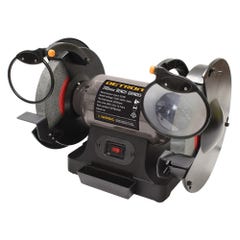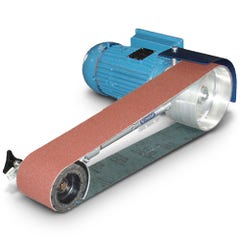Bench Grinders
Looking to buy the best quality bench grinder for your workshop? Your search ends here! Discover top-notch bench grinders that deliver precision and power, both online and in-store.
Buy the Best Quality Bench Grinders Online and In-Store!
Whether you're a professional craftsman or a DIY enthusiast, our selection offers the perfect balance of durability and performance. From sharpening tools to polishing surfaces, our bench grinders are versatile and built to last. Explore our wide range of options, find the perfect fit for your needs, and take your projects to the next level. Shop online or visit our store today to get your hands on the finest bench grinders available and experience the difference in your work!
Key Features to Look for in a Bench Grinder
When shopping for a bench grinder, it's essential to consider key features that will ensure you get the right tool for your needs. Here are some crucial features to look for:
- Motor Power: Choose a bench grinder with an adequate motor power rating. Higher horsepower (HP) allows for more efficient grinding and the ability to handle tougher materials.
- Wheel Size: Bench grinders come with different wheel diameters, typically 6 inches or 8 inches. Larger wheels provide more surface area for grinding, making them suitable for bigger tasks.
- Variable Speed: Some models offer variable speed settings, allowing you to adjust the wheel's rotation speed. This feature is valuable for precise grinding and working with different materials.
- Wheel Material: Ensure the grinding wheels are made from high-quality materials like aluminum oxide or silicon carbide, as they determine the grinder's durability and effectiveness.
- Wheel Grit: Pay attention to the grit rating of the grinding wheels. Coarser grits (36-60) are suitable for heavy material removal, while finer grits (80-120) are better for polishing and sharpening.
- Tool Rests and Eye Shields: Look for adjustable tool rests and protective eye shields. These safety features provide stability while grinding and protect your eyes from debris.
- Spark Deflectors: Bench grinders with spark deflectors help prevent sparks from flying, enhancing safety during operation.
- Dust Collection: Consider models with built-in dust collection systems or the option to attach external dust collectors. This keeps your workspace cleaner and reduces health risks.
- Build Quality: Opt for a bench grinder with a sturdy and stable construction. Cast iron or heavy-duty metal bases are common for durability.
- Warranty and Brand: Choose reputable brands with a track record of quality products. A good warranty offers peace of mind, ensuring your investment is protected.
- Size and Portability: Consider the physical dimensions of the grinder and whether it fits your workspace. Some bench grinders are more compact and portable, while others are designed for permanent installation.
- Price: Set a budget based on your needs but remember that investing in a higher-quality bench grinder can save you money in the long run due to its durability and performance.
Sharpening Tools with a Benchtop Grinder
Here's a step-by-step guide on how to effectively sharpen various types of tools using a benchtop grinder:
- Safety First:
- Wear safety goggles to protect your eyes from sparks and debris.
- Use ear protection as bench grinders can be noisy.
- Avoid loose clothing and wear protective gloves.
- Set Up the Grinder:
- Ensure the bench grinder is securely mounted to a stable surface.
- Make sure the grinder's wheels are properly aligned and not damaged.
- Choose the Right Wheel:
- Select the appropriate grinding wheel for the type of tool you're sharpening. For example, use a fine-grit wheel for sharpening chisels and a coarse-grit wheel for lawnmower blades.
- Adjust Tool Rest:
- Position the tool rest at the correct angle, typically at a 20-30 degree angle for most tools.
- Maintain a gap of 1/16 to 1/8 inch between the tool rest and the grinding wheel.
- Start Grinding:
- Turn on the bench grinder and wait for it to reach full speed before beginning.
- Hold the tool firmly with both hands and approach the grinding wheel at the correct angle.
- Use smooth, even strokes while maintaining a consistent angle to avoid creating uneven bevels.
- Cooling and Tempering:
- Periodically dip the tool into water or use a water-cooled sharpening system to prevent overheating and temper the metal.
- For heat-treated tools, avoid excessive heat to maintain their hardness.
- Check Progress:
- Pause occasionally to check the tool's edge for sharpness. Look for a clean, even edge with no nicks or irregularities.
- Balance and Test:
- If you're sharpening a tool with multiple cutting edges (e.g., lawnmower blades), ensure they're evenly balanced before reassembling the tool.
- Test the sharpness of the tool by using it on a suitable material or with a test cut.
- Final Touches:
- For woodworking tools like chisels and plane blades, finish the sharpening process by honing the edge with a sharpening stone or honing guide.
- Clean and Store:
- Turn off the bench grinder and clean up any debris and metal shavings.
- Store your sharpened tools in a safe and dry place.
Essential Safety Gears for using a Bench Grinder
- Safety Glasses or Goggles
- Ear Protection
- Respirator or Dust Mask
- Protective Gloves
- Long-Sleeved Clothing
- Closed-Toe Footwear
- Face Shield or Full-Face Protection
- Hair and Beard Protection
- Dust Collection System
- First Aid Kit
Discover Trusted Brands Offering Best Quality Bench Grinders
- Makita
- Milwaukee
- Bosch
- DeWalt
- HiKOKI
- Aeropro




































